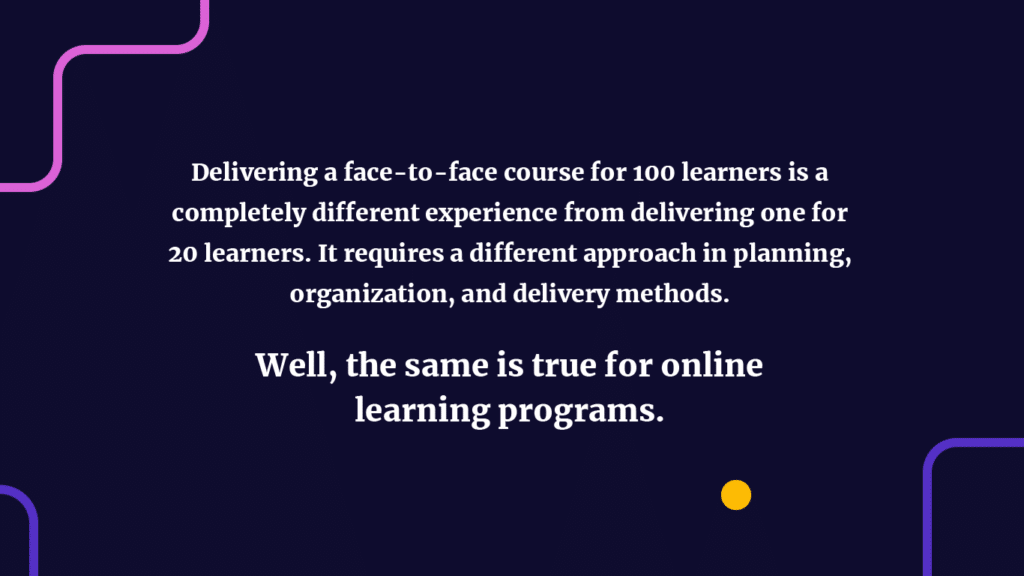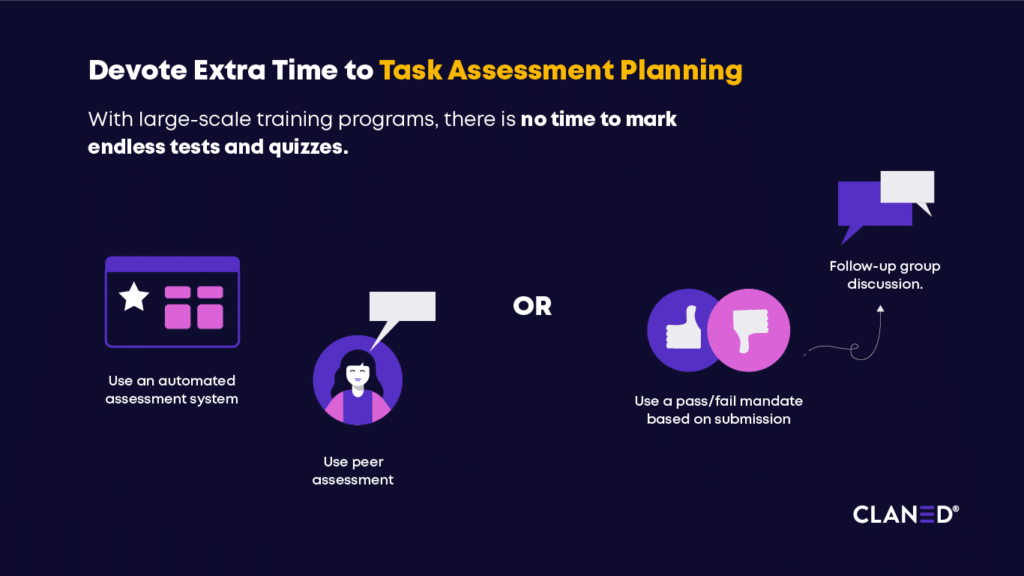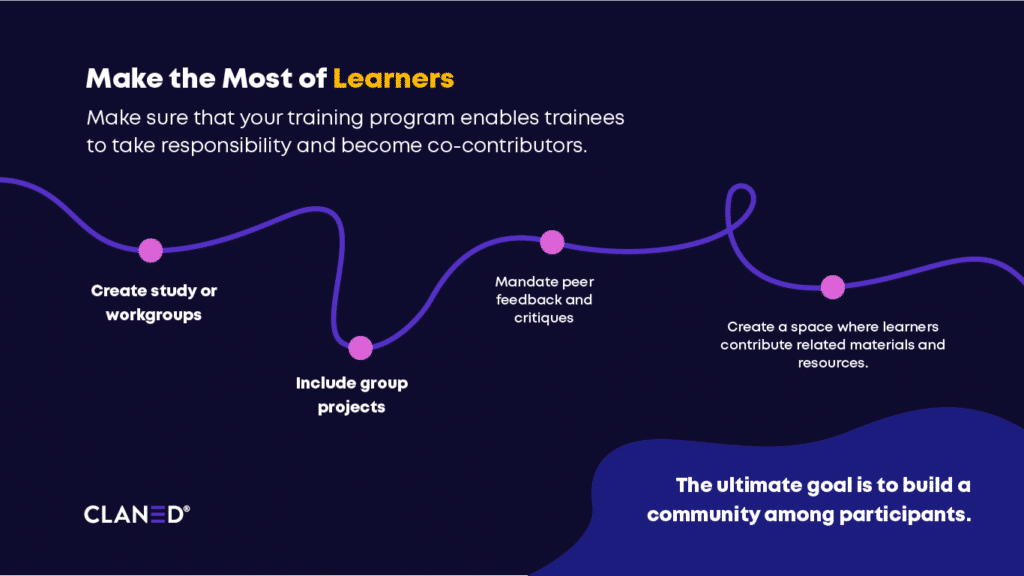There is so much that online learning brings to the table. From integrating new and exciting types of media to delivering an online training program and learning opportunities across the globe to diverse groups of learners, online learning is capable of feats that traditional training could never achieve.
But with that said, there’s a big misconception that often follows along. It is generally assumed that facilitating training at scale is as simple and easy as finding a suitable LMS/LXP, putting the needed materials online, and then inviting the learners.
We’re here to tell you that this is just not true.
Delivering a face-to-face course for 100 learners is a completely different experience from delivering one for 20 learners. It requires a different approach in planning, organization, and delivery methods.
Well, the same is true for online learning programs.

As easy as it might be to reach hundreds or even thousands of learners at a time, planning and designing your content and course structure with the scale in mind is critical to achieving success.
So let’s get to the good part: how do you facilitate learning at scale?
As is the case with designing most forms of learning experiences, it all comes down to planning, organizing, and mapping out exactly what you want to achieve, how to achieve it, and then verifying and communicating it effectively.
Plan, Plan, Plan Some More
All successful online learning programs have the benefit of being backed by a good plan. So when you start out on a mission to scale your training program, it’s probably best to focus on a single course rather than a suite of them. This allows you more time and resources to focus intensely on what needs to be done and makes it less likely that an element gets missed.
Once you have run an online training program at scale, you can take what you have learned from the experience apply it to future programs. These lessons could be in the form of frameworks or structures that worked well. They could also be in the form of identifying opportunities to assess what didn’t work so well, why that is the case, and how you could avoid it in future iterations and new courses. It will also help you estimate reasonable timelines and needs before undertaking new projects.
All of these elements can then factor into your future plans for training programs. Remember: it’s better to have one well-planned, polished, amazing course than five rough and messy ones. People will always be happy to wait a bit for engaging experiences far more than they will want to return to mediocre ones.
Focus on Facilitation
You might be planning to run a training program entirely unsupervised. Or, you might be opting to have dedicated facilitators to manage and communicate with groups of learners. Either way, planning and considering a solid facilitation model is a crucial step in scaling online training programs.
Say you go the route of having a facilitator involved at some level in the online training program. It is critical that all the training and information they will need in order to be successful in their role is planned out beforehand.
Likewise, if you’re opting for a facilitator-free program model, how do you ensure learners have support if and when they need it? In this case, it would be important that you have extremely clear instructions, fool-proof assessments and, should these not suffice, various points of contact available to them.
To understand the various forms of facilitation better, it might be helpful to imagine a facilitator in one of these 3 roles:

The Conductor
The least hands-on type of facilitator. In a training program, Conductors orchestrate a smooth learning experience by managing automated emails, notifications, and reminders for the learners. They may even go as far as organizing discussion boards, virtual meets, and replying to outstanding questions.
Conductors are generally “behind-the-scenes” actors but make occasional cameos at critical points in the program such as the beginning (welcome and introductions), the end (results and congratulations), and depending on the length of the course, somewhere during the middle (check-ins, updates, and clarifications).
The Counselor
Facilitators that engage in mid-level involvement. Counselors typically have more direct insight into what goes on in a course at somewhat of a weekly level. They monitor for trouble, but mostly let the participants work independently.
They provide motivational support through elements like notifications and updates, and may also run events such as regular discussion groups, feedback sessions on larger assignments, or engaging learners with leading questions related to large groups of materials. Counselors are expected to monitor and step in with support if they notice learners failing to keep up or struggling to deliver as expected.
The Coach
As a facilitator, the most hands-on of the three. Coaches regularly monitor the course and its participants, provide direct feedback, critiques, and support. That is why Coaches need to be someone with an intimate knowledge of the course content as well as expertise that expands beyond the materials of the course. They perform check-ins with the trainees either individually or in small groups, encourage reflection, and promote deep learning by offering the support learners need to excel.
Is there any overlap between these three roles? Sure, there is. What’s more, in any given training program, the nuances of the program and the group of trainees participating in it will affect to what degree these roles are ultimately enacted.
But regardless, keeping your chosen facilitation model in mind during the planning will help you to think effectively about what resources, instructions, and organizational and support structures you need to account for. More importantly, it will help ensure that when you finally go live, there are far fewer hiccups along the way.
Assess Your Materials
Are you dealing with a complex or “boring” subject? If so (and even if not), paying close attention to your materials, how they are presented, and what you expect trainees to take away from them will affect how you scale your training program.
When presenting a course to a large number of people, never assume that a particular thing will immediately make sense. And if a particular topic or problem continues to pose challenges for the learners, always assume that additional explanations will be necessary.

Also, ask yourself an important question: Are your materials engaging? At the end of the day, we’re looking for informed and engaged learners which is why the materials need to be not only clear but also enjoyable. Can a set of slides be presented as a short video? Are there reflection questions that can be posed in a discussion forum instead of being assigned individually? In general, aim to include moments and opportunities where transparency and accountability (on the part of the learners) are present. As a result, we accomplish two key things: supporting learner engagement and making expectations clear.
READ: 5 Best Product Training LMS: To Upskill Your Employee and Improve Team Collaboration
Devote Extra Time to Task and Assessment Planning in your Training Program
Planning how you will assess trainees is always an important step. But when you’re facilitating a training program on a large scale, it comes with some inherent limitations. No one has time to be (or should be) marking endless tests and quizzes.

That is why using assessments that can be marked by an automated system can be incredibly useful. Using peer assessment (learners assess and provide feedback on each other’s work) is also a great way to lighten the load. If your assignments don’t fit either of these formats, you could also use a pass/fail mandate based simply on submission, and then pair it with a follow-up group discussion.
Make the Most of Learners
All learners have something to share, encouraging course participants to become co-creators and to take some responsibility for their own and each other’s learning process. So make sure that your training program has support systems in place that enable the trainees to take responsibility and become co-contributors.

This can be done in a multitude of ways: creating study or work groups, including group projects, requiring peer feedback and critiques, or creating a space within your course where learners can contribute related materials and resources. All of these are sure-fire ways to keep your learners involved and engaged.
If you have a facilitator in a Counselor or Coach role, you could mandate them to engage in regularly scheduled group discussions (accompanied by questions and deeper explanations) and provide the learners with any resources they might need.
The ultimate goal is to build a community among participants (see Chris‘s post about this). The greater the sense of community you facilitate for your learners, the more active a role they will take in contributing and supporting other learners in the program.
“Oops-Proof” Your Instructions in Your Training Program
Never, never assume that everything will always be understood. It is crucial to make your instructions, expectations, and responsibilities as clear as humanly possible. This applies to every single thing: in the training program: from the weekly or thematic module instructions to all the content-specific descriptions.
With all these, make sure to cover the basics: what it is, why the trainees are doing it, what they should know or be able to do by the end of it, and how to move on to the next step. If you notice a particular point of confusion during the course, go back to your instructions and update them, using an announcement or automated email to communicate this to the learners.
Time for a Training Program Postmortem
If you’re running an online training program at scale, it’s likely that you will have future iterations of the same program or other similar programs at some point. Which is why using the experiences of previous programs to identify what could be improved or would need attention in future programs is such a great opportunity.
Keep in mind any pain points or points of confusion expressed by learners and think: why did they occur? Having an LXP/LMS that offers analytic reporting and easily delivers stats on completion rates and participation numbers can be a big help here. Being able to identify overall trends helps focus your attention on where it needs to be and helps you avoid pouring effort and resources into fringe cases. The result? You (and your learners) always get the most out of any training program at scale.
Parting Words For Your Training Program
All of that is to say that running online training programs at scale or scaling up your courses for a wider audience needs a bunch of additional considerations in order to be successful. With proper planning and consideration of the elements being the biggest factor in its success, large-scale training programs can also turn out to be immensely effective and enjoyable.

In many ways, the considerations do not differ much from those of smaller-scale training programs and courses. But keeping in mind the scale of the program and how it affects what we ask learners to do and how we ask them to do it, is critical for both learner and program success.
Following the suggestions laid out in this blog post can be a great guide on that scaling-up journey and can help mitigate several problems along the way. Looking for more help in designing your at-scale training? Reach out to us at Claned, and our team of learning designers will identify and manage the issues specific to your course and help you facilitate successful, at-scale trainings.







